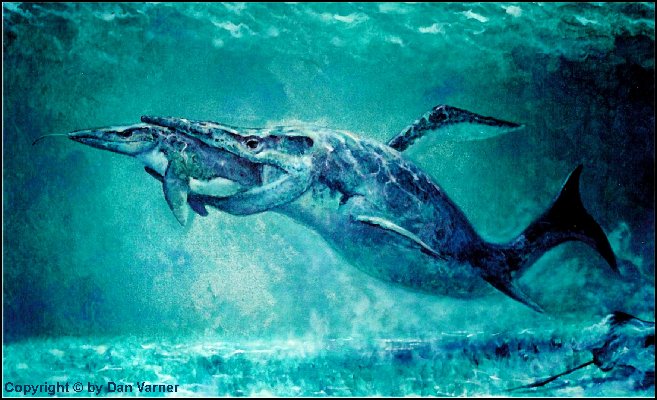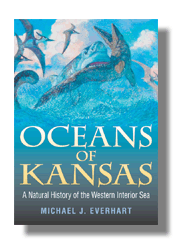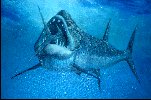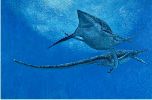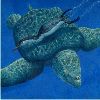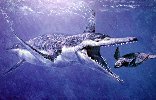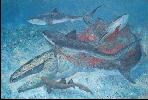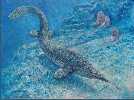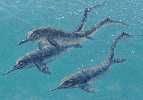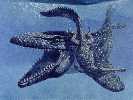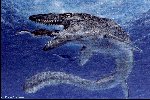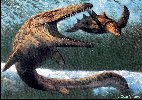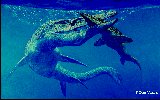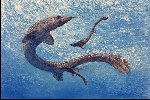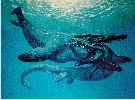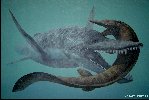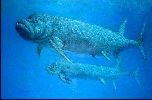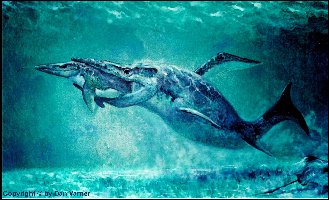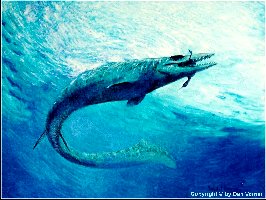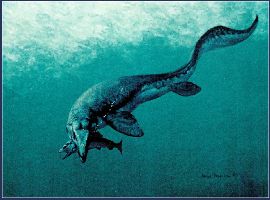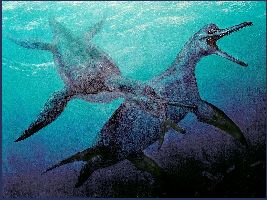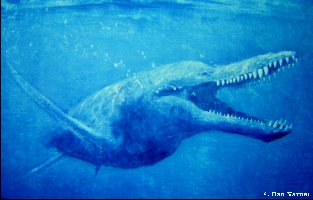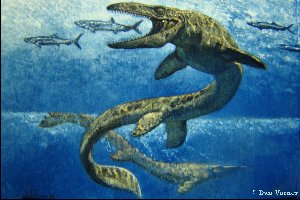Everhart, M.J. 2011. Rediscovery
of the Hesperornis regalis Marsh 1871 holotype locality indicates an
earlier stratigraphic occurrence.
Kansas
Academy
of Science, Transactions 114(1-2):59-68.
Martin, J.E. 2007. A
new species of the durophagous mosasaur, Globidens (Squamata:
Mosasauridae) from the Late Cretaceous Pierre Shale Group of central South
Dakota, USA. Pages 167-176 in Martin, J. E. and Parris D. C. (eds.), The Geology and Paleontology of the Late Cretaceous Marine Deposits of the
Dakotas. Geological Society of America, Special Paper 427.
Martin, J.E. 2007. A North American Hainosaurus (Squamata: Mosasauridae) from the
Late Cretaceous of southern South Dakota. Pages 199-207 in Martin, J. E. and
Parris D. C. (eds.), The Geology and Paleontology of the Late Cretaceous Marine Deposits of the
Dakotas. Geological Society of America, Special Paper 427.
Martin, J.E. and Bjork, P.R. 1987. Gastric residues associated with a
mosasaur from the late Cretaceous (Campanian) Pierre Shale in South Dakota,
Dakoterra, 3:68-72.
Martin, J.E. and
Cordes-Person, A. 2007.A new species of the diving bird, Baptornis (Ornithurae:
Hesperornithiformes), from the lower Pierre Shale Group (Upper Cretaceous) of
southwestern South Dakota. Pages 227-237 in Martin, J.E. and Parris D.C. (eds.),
The Geology and Paleontology of the Late Cretaceous Marine Deposits of the
Dakotas. Geological Society of America, Special Paper 427.
Martin, J.E. and
Fox, J.E. 2007. Stomach contents of Globidens,
a shell-crushing mosasaur (Squamata), from the Late Cretaceous Pierre Shale
Group, Big Bend area of the Missouri River, central South Dakota. Pages 167-176
in Martin, J.E. and Parris D.C. (eds.), The
Geology and Paleontology of the Late Cretaceous Marine Deposits of the Dakotas.
Geological Society of America, Special Paper 427.
Martin, J.E. and Fox, J.E. 2004. Molluscs in
the stomach contents of Globidens, a shell crushing mosasaur, from the
Late Cretaceous Pierre Shale, Big Bend area of the Missouri River, central South
Dakota. Geological Society of America, 2004 Rocky Mountain and Cordilleran
Regions Joint Meeting, Abstracts with Programs, 36(4):80.
Martin, J.E. and Kennedy, L.E. 1988. A plesiosaur from the late
Cretaceous (Campanian) Pierre Shale of South Dakota: A preliminary report,
Proceedings South Dakota Academy of Science, 67:76-79.
Martin, J.E., Schumacher, B.A., Parris, D.C. and Grandstaff, B.S.
1998. Fossil vertebrates of the Niobrara Formation in South Dakota, Dakoterra
5:39-54.
Martin,
J.E. and Varner, D.W. 1992. The occurrence of Hesperornis
in the Late Cretaceous Niobrara Formation of South Dakota. Proceedings of the
South Dakota Academy of Science 71:95-97.
Martin,
J.E. and Varner, D.W. 1992. The highest stratigraphic occurrence of the fossil
bird Baptornis. Proceedings of the
South Dakota Academy of Science 71:167 (abstract).
Schumacher, B.A. 2008. On the skull of a pliosaur
(Plesiosauria; Pliosauridae) from the Upper Cretaceous (Early Turonian) of the
North American Western Interior. Kansas Academy of Science, Transactions
111(3-4):203-218.
Schumacher, B.A. 2011. A ‘woollgari-zone mosasaur’ (Squamata; Mosasauridae) from the Carlile
Shale (Lower Middle Turonian) of central
Kansas
and the stratigraphic overlap of early mosasaurs and pliosaurid plesiosaurs.
Kansas
Academy
of
Science, Transactions 114(1-2):1-14.
Schumacher, B.A. 2008. On the skull of a pliosaur
(Plesiosauria; Pliosauridae) from the Upper Cretaceous (Early Turonian) of the
North American Western Interior. Kansas Academy of Science, Transactions
111(3-4):203-218.
Schumacher, B.A. 2011. A ‘woollgari-zone mosasaur’ (Squamata; Mosasauridae) from the Carlile
Shale (Lower Middle Turonian) of central
Kansas
and the stratigraphic overlap of early mosasaurs and pliosaurid plesiosaurs.
Kansas
Academy
of
Science, Transactions 114(1-2):1-14.
Schumacher, B.A. and M. J. Everhart. 2005. A
stratigraphic and taxonomic review of plesiosaurs from the old “Fort Benton
Group” of central Kansas: A new assessment of old records.
Paludicola 5(2):33-54.
Schumacher, B.A. and Varner, D.W. 1996. Mosasaur caudal anatomy.
Journal of Vertebrate Paleontology, 16(suppl. to 3):63A.
Schumacher, B.A. and Varner, D.W.
2007. Morphology and function of tailbends in mosasaurs. In Everhart M.J. (ed.),
Second mosasaur meeting, Abstract Booklet and Field Guide, pp 41–42.
